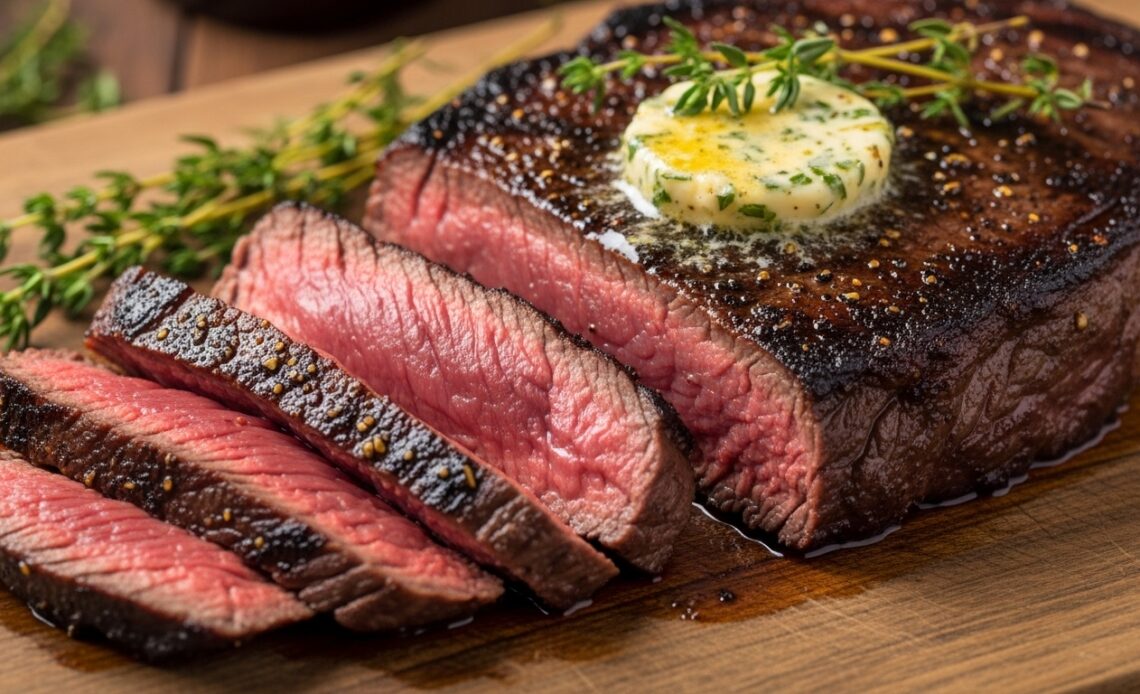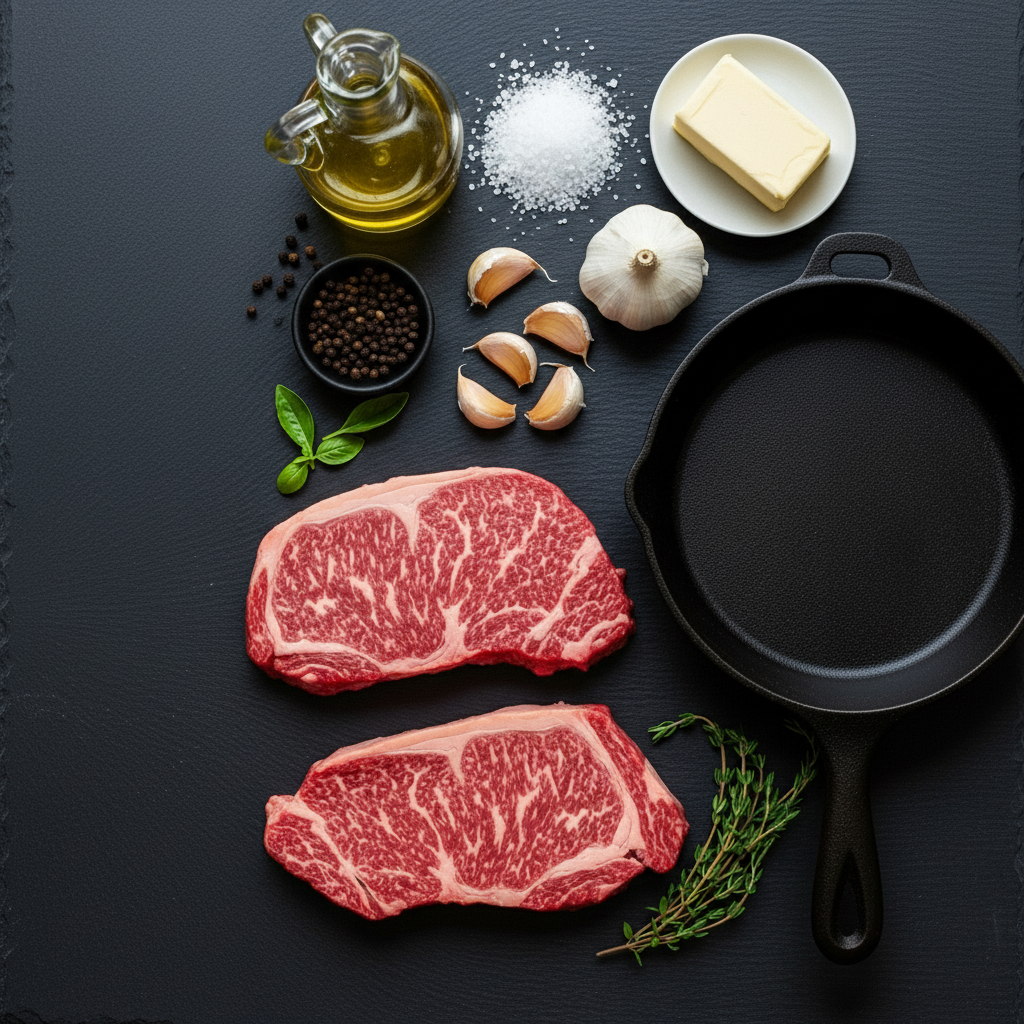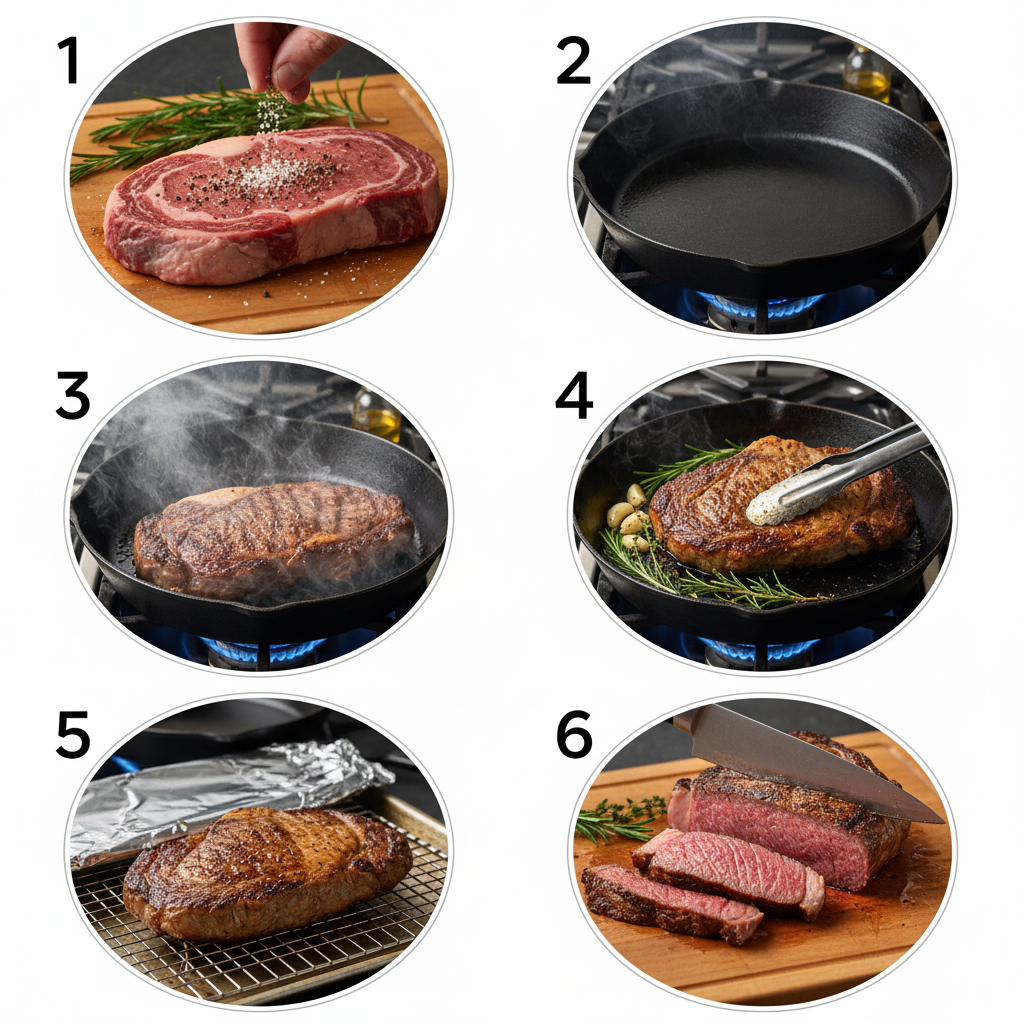
Did you know that flat iron steak ranks as the second most tender cut of beef after the tenderloin, yet costs roughly 40% less per pound? This hidden gem has transformed from a butcher’s secret into one of the most sought-after cuts for home cooks seeking restaurant-quality results without the premium price tag. The flat iron steak, also known as the top blade steak, delivers exceptional marbling, rich beefy flavor, and fork-tender texture when prepared correctly. Whether you’re a seasoned grill master or a kitchen novice, mastering this versatile cut will elevate your cooking repertoire and impress dinner guests every time. In this comprehensive guide, we’ll walk you through everything you need to know about selecting, seasoning, and cooking flat iron steak to absolute perfection.
Ingredients List

For the Steak:
- 2 flat iron steaks (8-10 oz each, about 1 inch thick)
- 2 tablespoons high-smoke-point oil (avocado, grapeseed, or refined olive oil)
- 2 teaspoons coarse sea salt or kosher salt
- 1 teaspoon freshly cracked black pepper
- 3 cloves garlic, smashed (or substitute with 1 teaspoon garlic powder)
- 3 sprigs fresh thyme or rosemary (or substitute with 1 teaspoon dried herbs)
- 2 tablespoons unsalted butter (or ghee for a richer flavor)
Substitution Suggestions:
- For a leaner option, reduce butter to 1 tablespoon or use olive oil spray
- Swap fresh herbs with dried oregano, sage, or a steak seasoning blend
- Use grass-fed beef for enhanced omega-3 content and deeper flavor
- Try coconut aminos or tamari for an umami boost (1 tablespoon)
Timing
Preparation Time: 10 minutes (including bringing steak to room temperature) Cooking Time: 8-12 minutes (depending on desired doneness) Resting Time: 5-7 minutes Total Time: 25-30 minutes
This efficient timeline makes flat iron steak ideal for weeknight dinners, delivering steakhouse quality in approximately 30 minutes—that’s 35% faster than traditional roasting methods while maintaining superior tenderness and flavor development.
Step-by-Step Instructions

Step 1: Prepare Your Steak
Remove the flat iron steaks from refrigeration 30-45 minutes before cooking to allow them to reach room temperature. This crucial step ensures even cooking throughout the meat. Pat both sides completely dry using paper towels—moisture is the enemy of a perfect sear. Season generously with salt and freshly cracked black pepper on all surfaces, pressing the seasonings gently into the meat to create maximum adherence.
Pro Tip: The drier the surface, the better your crust will be. Consider salting your steak 1-2 hours in advance for enhanced flavor penetration and moisture retention.
Step 2: Preheat Your Cooking Surface
Heat a heavy-bottomed skillet (cast iron works exceptionally well) or grill over high heat for 5 minutes until smoking hot. For pan cooking, add your high-smoke-point oil and swirl to coat the entire surface. The pan should shimmer and nearly smoke—this intense heat creates the coveted Maillard reaction that delivers that irresistible caramelized crust.
Pro Tip: Test readiness by flicking a water droplet onto the surface; it should evaporate instantly with a sizzle.
Step 3: Sear the First Side
Carefully lay the flat iron steak into the hot pan or onto the grill, laying it away from you to prevent oil splatter. Resist the temptation to move it—let it sear undisturbed for 4-5 minutes. You’ll know it’s ready to flip when the steak releases easily from the cooking surface and displays a deep golden-brown crust with darker charred edges.
Pro Tip: For perfect grill marks, position your steak at a 45-degree angle and rotate once halfway through cooking each side.
Step 4: Flip and Add Aromatics
Using tongs, flip the steak confidently to sear the second side. Immediately add smashed garlic cloves, fresh herb sprigs, and butter to the pan. As the butter melts and foams, tilt the pan slightly and use a spoon to baste the steak continuously with the aromatic butter mixture. This technique adds layers of flavor and promotes even cooking. Cook for an additional 3-4 minutes for medium-rare (internal temperature of 130-135°F).
Pro Tip: Use an instant-read thermometer inserted horizontally into the thickest part for accuracy: 120-125°F for rare, 130-135°F for medium-rare, 140-145°F for medium.
Step 5: Rest Your Steak
Transfer the cooked flat iron steak to a cutting board and tent loosely with aluminum foil. Allow it to rest for 5-7 minutes—this critical step allows the juices to redistribute throughout the meat, ensuring every bite is succulent. The internal temperature will rise an additional 5 degrees during this resting period.
Pro Tip: Reserve the pan drippings to create a quick sauce by deglazing with red wine or beef broth.
Step 6: Slice and Serve
Identify the grain direction in your flat iron steak (the parallel muscle fibers). Using a sharp knife, slice against the grain at a slight angle into ¼-inch strips. This cutting technique is essential—slicing against the grain shortens the muscle fibers, transforming an already tender cut into butter-soft perfection.
Pro Tip: Angle your knife at 45 degrees for elegant, restaurant-style presentation.
Nutritional Information
Per 6 oz serving of flat iron steak:
- Calories: 310
- Protein: 42g (84% DV)
- Total Fat: 14g (18% DV)
- Saturated Fat: 5g (25% DV)
- Monounsaturated Fat: 6g
- Cholesterol: 125mg (42% DV)
- Sodium: 580mg (25% DV when seasoned as directed)
- Iron: 3.2mg (18% DV)
- Zinc: 8.5mg (77% DV)
- Vitamin B12: 2.8mcg (117% DV)
- Niacin (B3): 11mg (69% DV)
Flat iron steak provides exceptional nutritional density, delivering high-quality complete protein with all nine essential amino acids. It’s particularly rich in vitamin B12, supporting nerve function and red blood cell formation, and zinc, which promotes immune health and wound healing. The cut contains a favorable balance of healthy monounsaturated fats along with beneficial conjugated linoleic acid (CLA).
Healthier Alternatives for the Recipe
Reduce Saturated Fat: Trim any visible fat from the steak edges before cooking and reduce butter to 1 tablespoon or substitute with heart-healthy olive oil.
Lower Sodium: Use half the recommended salt and enhance flavor with sodium-free seasonings like smoked paprika, cumin, or a custom blend of garlic powder, onion powder, and dried herbs.
Grass-Fed Beef: Choose grass-fed flat iron steak for up to 5 times more omega-3 fatty acids and higher levels of antioxidants like vitamin E compared to grain-fed alternatives.
Portion Control: Serve 4-5 oz portions alongside generous helpings of roasted vegetables or leafy greens to create a balanced, nutrient-dense plate.
Mediterranean Style: Marinate the steak in lemon juice, olive oil, garlic, and oregano for 2-4 hours before cooking to infuse Mediterranean flavors while reducing the need for excessive salt and butter.
Asian-Inspired: Create a teriyaki-style preparation using low-sodium soy sauce, fresh ginger, and a touch of honey for a flavor-packed alternative with reduced saturated fat.
Serving Suggestions
Transform your perfectly cooked flat iron steak into a complete dining experience with these creative presentation ideas:
Classic Steakhouse Style: Serve sliced steak alongside garlic mashed potatoes, grilled asparagus spears, and a robust red wine reduction sauce. Top with compound butter infused with blue cheese and chives for an indulgent finish.
Fresh Salad Bowl: Arrange warm sliced steak over a bed of mixed greens, cherry tomatoes, cucumber, avocado, and crumbled feta cheese. Drizzle with balsamic vinaigrette and toasted pine nuts for a lighter, nutrient-balanced meal.
Steak Tacos: Slice the meat thinly and serve in warm corn or flour tortillas with pico de gallo, fresh cilantro, lime wedges, and creamy avocado crema for a crowd-pleasing fusion approach.
Asian Rice Bowls: Place steak strips over jasmine or cauliflower rice with stir-fried vegetables, edamame, and sesame seeds. Finish with sriracha mayo or a ginger-soy glaze.
Sandwich Supreme: Layer sliced steak on toasted ciabatta with caramelized onions, arugula, horseradish aioli, and aged white cheddar for a gourmet sandwich experience.
Wine Pairing: Flat iron steak‘s rich marbling and beefy flavor pairs beautifully with full-bodied red wines like Cabernet Sauvignon, Malbec, or Syrah. For white wine enthusiasts, try an oak-aged Chardonnay.
Common Mistakes to Avoid
Cooking from Cold: Placing refrigerator-cold steak directly onto heat causes uneven cooking—the exterior overcooks while the interior remains underdone. Always allow 30-45 minutes for room temperature equilibration.
Overcrowding the Pan: Placing multiple steaks too close together drops the pan temperature dramatically, resulting in steaming rather than searing. Cook in batches if necessary, maintaining at least 2 inches between pieces.
Flipping Too Frequently: Resist the urge to constantly flip or move your steak. Each side needs uninterrupted contact time (4-5 minutes) to develop proper crust formation through the Maillard reaction.
Skipping the Resting Period: Cutting into steak immediately after cooking causes valuable juices to flood out onto the cutting board rather than remaining in the meat. A 5-7 minute rest is non-negotiable for juicy results.
Slicing With the Grain: Even the most tender flat iron steak becomes chewy when sliced parallel to the muscle fibers. Always identify the grain and slice perpendicular to it for maximum tenderness.
Using a Dull Knife: A dull blade tears and shreds meat fibers rather than making clean cuts. Keep your knives professionally sharpened or use a honing steel before slicing.
Overcooking: Flat iron steak is best enjoyed at medium-rare to medium doneness. Beyond 145°F internal temperature, the proteins contract excessively, squeezing out moisture and creating a drier, tougher texture.
Storing Tips for the Recipe
Refrigeration: Allow leftover flat iron steak to cool to room temperature (within 2 hours of cooking), then wrap tightly in plastic wrap or store in an airtight container. Properly stored, cooked steak remains fresh for 3-4 days in the refrigerator.
Freezing: For longer storage, wrap individual portions in plastic wrap, then in aluminum foil or freezer paper. Place in freezer-safe bags, removing as much air as possible. Frozen cooked steak maintains quality for 2-3 months.
Reheating: The microwave often results in rubbery, overcooked meat. Instead, reheat gently in a 250°F oven for 15-20 minutes, or slice thinly and quickly sauté in a hot pan with a splash of beef broth.
Raw Steak Storage: Keep uncooked flat iron steak in its original packaging or wrapped tightly in plastic on the lowest refrigerator shelf (to prevent cross-contamination) for 3-5 days. For freezing raw steak, use vacuum-sealed bags or wrap thoroughly in plastic and foil; it keeps for 6-12 months.
Meal Prep Strategy: Season and individually wrap raw steaks, then freeze. Transfer to the refrigerator 24 hours before cooking for convenient weeknight meals with minimal preparation time.
Leftover Ideas: Transform day-old steak into steak and eggs for breakfast, cold steak salads, quesadillas, fried rice, or hearty beef and vegetable soup.
Conclusion
Mastering flat iron steak elevates your home cooking instantly, delivering tender, flavorful results that rival expensive steakhouse meals. The key elements—proper seasoning, high-heat searing, strategic resting, and slicing against the grain—work together to unlock this cut’s full potential. With its impressive nutritional profile, affordability, and versatility, flat iron steak deserves a permanent place in your cooking rotation.
Ready to experience steakhouse-quality beef at home? Try this recipe tonight and discover why flat iron steak has become a favorite among chefs and home cooks alike. Share your cooking results, tips, and creative serving ideas in the comments below—we’d love to hear about your experience! Don’t forget to rate this recipe and subscribe to our blog for more expert cooking guides, ingredient spotlights, and kitchen techniques delivered straight to your inbox.
FAQs
Q: What exactly is flat iron steak, and where does it come from? A: Flat iron steak is cut from the shoulder (chuck) area of the cow, specifically the top blade muscle. After removing the tough central connective tissue, butchers create two uniform, rectangular steaks that resemble old-fashioned flat irons. This cut has gained popularity since the early 2000s when researchers identified it as exceptionally tender.
Q: How do I know when my flat iron steak is done without a thermometer? A: While an instant-read thermometer provides accuracy, you can use the touch test: press the center of the steak with your finger. Rare feels soft and squishy (like the flesh at the base of your thumb when relaxed), medium-rare feels slightly firmer with some give (touch thumb to index finger), and medium feels firm with slight resistance (thumb to middle finger).
Q: Can I marinate flat iron steak, or is dry seasoning better? A: Both methods work beautifully! Flat iron steak’s natural tenderness means it doesn’t require tenderizing marinades, but acidic marinades (citrus, vinegar, wine) can add flavor complexity. Marinate for 2-8 hours maximum. For optimal crust development, pat the steak completely dry before cooking, regardless of seasoning method.
Q: Why is my flat iron steak chewy even though I cooked it to the right temperature? A: The most common culprit is slicing with the grain instead of against it. Flat iron steak has visible muscle fibers running in one direction—you must slice perpendicular to these lines. Also ensure you’re resting the meat adequately (5-7 minutes) before cutting.
Q: What’s the difference between flat iron steak and flank or skirt steak? A: While all three are flavorful and benefit from slicing against the grain, flat iron steak is significantly more tender (second only to tenderloin) and contains more marbling. Flank and skirt steaks are leaner, chewier, and typically require marinating. Flat iron steak is thicker and better suited for high-heat cooking methods.
Q: Can I cook flat iron steak in the oven? A: Absolutely! Use the reverse-sear method: place steak on a wire rack over a baking sheet and cook at 275°F until it reaches 10-15 degrees below your target temperature (about 20-30 minutes). Then sear in a blazing hot skillet for 1-2 minutes per side to develop crust.
Q: Is flat iron steak a healthy choice? A: Yes! It provides high-quality protein, essential B vitamins, iron, and zinc while containing less saturated fat than ribeye or other premium cuts. A 6 oz serving delivers 42g of protein with only 310 calories, making it excellent for muscle maintenance and satiety.
Q: Where can I buy flat iron steak, and what should I look for? A: Most grocery store meat departments carry flat iron steak, though you may need to ask the butcher specifically. Look for bright red color, visible marbling (white fat streaks throughout), and steaks that are uniformly 1-1.5 inches thick. Avoid any with brown discoloration or excessive liquid in the package.

